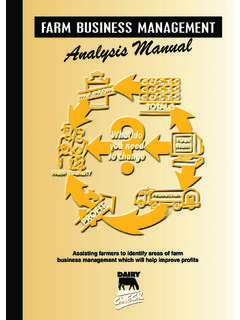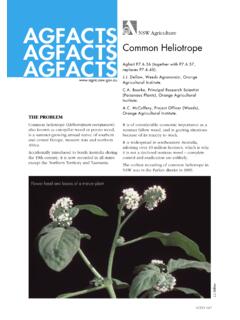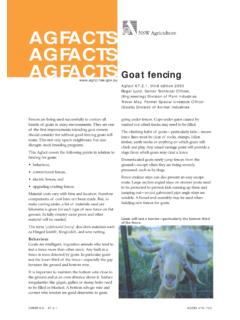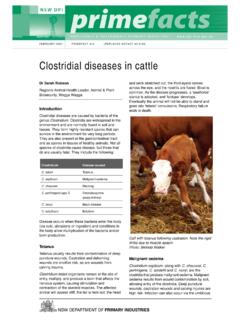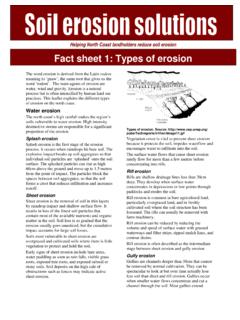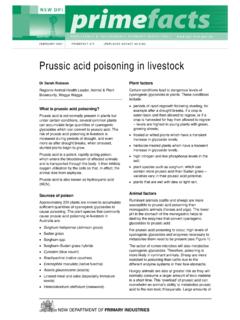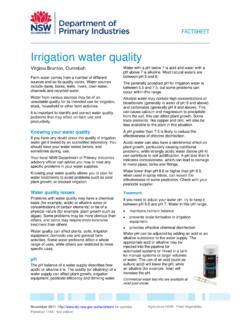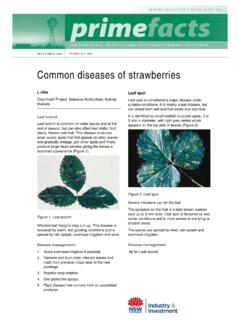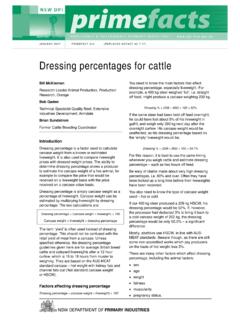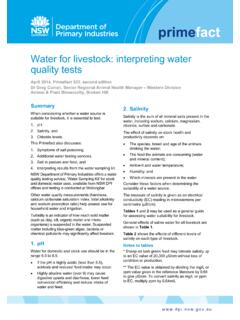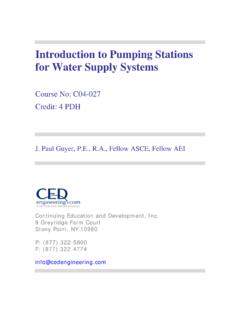Transcription of Building a farm dam - Department of Primary Industries
1 OCTOBER 2009 PRIMEFACT 781 (REPLACES AGFACT ) Building a farm damBill Yiasoumi Irrigation Officer, Richmond John O'Connor Resource Management Officer, Berry Building a farm dam is not a case of digging a hole and waiting for it to fill with water. Many farm dams fail because they were not planned or built properly. Most farm dams are compacted earth structures built at depressions, gullies or hillsides. farm dams should be planned and built with the same care you would apply to Building a house. There are several things to consider when planning a dam. These can limit the size of the dam that can be built without a licence, or they can impact on its location: Government regulations that apply to your dam, including the maximum allowable size; Size of your dam, allowing for farm water needs and evaporation losses; Where to build your dam. There are also several things to consider when Building a farm dam, such as: Who should build your dam; Preparing your site; Building your dam; Maintaining your dam.
2 Government regulations The NSW Government has been reforming water management across the State since the 1990s and has introduced a range of changes that may impact on the size and location of new farm dams. The NSW Office of Water (formerly Department of Water & Energy) manages water access and licensing and has prepared a range of information sheets to update and guide landholders who intend to construct dams. These can be accessed through the NSW Office of Water website at: These links outline the Maximum Harvestable Right for farm Dams where this is relevant, and the rules in the Western Division of the State. The NSW Office of Water can advise as to what size you can build without needing a licence. If a larger capacity is needed, then a licence may need to be issued. In addition to criteria based on volumes, there are exemptions to the rules which may apply to you. The Office of Water can advise about these exemptions. Some councils require a development application for every dam built in their area.
3 Check with your local council to see if you must comply with a development control plan. farm dams can be built on minor watercourses (lower order streams) but not on larger streams, unless they are approved by the Office of Water. The Office of Water website contains information on where dams can be built (see the above website). On some watercourses a dam may require provision for fish passage under the Fisheries Management Act 1994 for dams. Your local Industry & Investment NSW office will be able to refer you to someone who will be able to provide further advice. Figure 1: A cross-section of a typical dam 2 PRIMEFACT 781, Building A farm DAM Under the Native Vegetation Act 2003, land in, or within 20 metres of, the bed or bank of a prescribed stream is regarded as Vulnerable Land and clearing of native vegetation is generally not permitted. You can confirm the status of the stream and associated native vegetation with your Catchment Management Authority (CMA) or at.
4 For more information on Native Vegetation Act see: Sometimes, special permits are issued to allow tree removal. It is advisable to check with the Office of Water before you start Building , as they can confirm whether or not a dam can be constructed at the proposed site. The Office of Water also assess the suitability of works at, or near a watercourse, lake or estuary. A permit is required for any excavations, placement of fill or construction in or near these areas. You should approach the Office of Water to find out if your dam is affected. A useful checklist can be found at the Office of Water website listed above. Some dams may need to be registered with the Dam Safety Committee, which considers the consequences of dam failure. Although registration is required for very few farm dams, you should check the need for registration by contacting the Dam Safety Committee at the Parramatta office of the Office of Water. Telephone: 02 9895 7363 Facsimile: 02 9895 7354 Email: Website: Size of your dam When determining dam size you will need to consider farm water requirements.
5 If these exceed your Maximum Harvestable Right or the rules for the Western Division of the State you will need to obtain a licence or consent from the Office of Water. Maximum Harvestable Right allowances vary across the State and depend on property location and property size. A calculator for them can be found at the Office of Water website shown above. Water requirements also vary considerably depending on crop type, geographic location, stock type and stock numbers. For example, pastures grown at Bega usually need less irrigation water than pastures grown at Dubbo. Similarly, 100 sheep need less water than 100 cows. Determine how much water you need and the allowable capacity before you start Building . The Office of Water have a work sheet on estimating stock and domestic water needs at the Office of Water website listed above. If the dam will be used for irrigation, this may increase its size considerably, depending on what proportion of the crop s water needs the storage will hold.
6 Indicative average annual irrigated water requirements across the State are: pastures: 4 6 ML/ha a year vines: 2 3 ML/ha a year vegetables: 3 5 ML/ha a year stone fruit: 3 4 ML/ha a year 1 m3 = 1 cubic metre = 1 kilolitre = 1000 L 1 ML = 1 megalitre = one million litres Remember, these figures are for guidance only and may be quite different for your particular situation. Further advice is available from your local Irrigation Officer or District Agronomist. Evaporation losses Evaporation losses from the dam must also be considered in the size of the storage. Evaporation losses from a storage are not constant and vary from month to month and from location to location. Higher evaporation losses can be expected in summer than in winter and higher losses can be expected inland than on the coast. Average evaporation losses could be as low as 1,400 millimetres per year on the coast and as high as 3,600 millimetres per year inland.
7 This equates to annual evaporation losses of around 14 36 ML per ha of water surface. There are several options available for the reduction of evaporation losses from farm storages; initially the most desirable is to make the storage as deep as possible to reduce its surface area. Once built, the options to reduce evaporation all present a barrier between the water surface and the atmosphere. The barriers are either physical or chemical; some of the options to limit evaporation from dams are outlined in the section Some maintenance tips at the end of this Primefact. Where to build your dam Once you have estimated how much water you need, the next thing to do is to establish where to put the dam. Remember the dam site you choose will determine its success. A gully is usually a good place to site a dam because it reduces the amount of earthworks and the overall cost. However, not everyone has the advantage of a gully site on their property; many farm dams are built on hillsides.
8 Two important considerations, the catchment yield and the soil type at the site, will help you to choose the best location for your dam, but you need to make sure that stream order is appropriate, by checking with local Office of Water licensing staff, who can also advise on any licensing or approvals that may be required. The yield of the catchment Unless your dam fills from a spring or by pumping from a river or bore, the source of water will be rainfall that runs off the catchment. The catchment is the area that collects rainfall run-off and directs it to the dam. The catchment can be natural, like fields and forest, or it can be artificial, like roads and roofs. Generally, as catchment area increases, so does the volume of run-off water. The amount of run-off also depends on several other factors, including: ground slope rainfall intensity type of ground cover soil type existing drainage patterns. If the catchment is not likely to provide the amount of run-off water you need, then you may be able build catch drains.
9 These drains collect run-off water from outside the dam catchment area and direct it to the dam. The drains need to be built carefully to ensure a grade towards the dam and they should be sealed with a covering of grass to avoid erosion. In some areas floodplain harvesting rules may prevent diversions. Office of Water licensing staff and local government authorities will be able to advise you as to the location and purpose for which you can capture overland flow in your area. Table 1 will help you to estimate the likely yield of your catchment. For example, if your average annual rainfall is around 750 mm and your catchment area is 4 ha, then you could expect an average 3 ML yield from the catchment annually. Remember, the tabulated yields have been derived using assumptions regarding: slope soil type ground cover catchment geometry drainage paths. Table 1. Catchment yield Average annual rainfall (mm) Average annual yield per hectare of catchment (ML)500 750 1000 1250 An accurate assessment of your catchment yield can only be made after investigation of the characteristics of your catchment.
10 The type of soil at the site The embankment must be structurally stable and able to hold water. This means that the soil used to build the embankment must also be structurally stable or impermeable preferably both. The soil type that usually satisfies both these criteria is clay. However, not all clays are suitable for dam embankments. For example, some clays disperse when wet and result in tunnels forming in the embankment. Thus, the soil must be tested to determine its behaviour. To do the tests, samples of the soil must be obtained from the excavation area including the borrow pit which will provide much of the earth for the embankment (shown in Fig 6). The samples can come from auger holes or backhoe trenches. The sampling depth should extend at least to the depth of anticipated excavation. Sampling the site will also give you an idea if there is enough soil in the excavation area to build the embankment. The samples should be tested by someone experienced with soil behaviour in dam construction.
